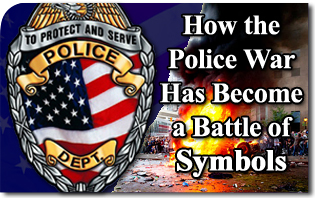 For some time now, America has seen massive unrest in the wake of several tragic deaths of young black men at the hands of police officers.
For some time now, America has seen massive unrest in the wake of several tragic deaths of young black men at the hands of police officers.
The most important part of the debate has been separating the facts from the media myths about what actually happened. There are those who claim these incidents involve arbitrary action and police brutality. Media have done much to dramatize the situation. However, the central point was always the facts. It fell upon the police and the judicial system to objectively discern the facts of what really took place and then deliver a verdict of justice to those involved.
With the horrifying assassination of policemen in Dallas and Baton Rouge, the center of the debate has shifted. The killing of policemen simply because they are policemen has escalated the controversy into a battle not of facts but of symbols.
In a battle of symbols, the facts necessarily take on a secondary importance. This is because a symbol is a visual representation of an ideal that is not visible. The objective is to present the ideal in a form that transcends the concrete reality. The nation’s flag, for example, is a symbol that represents the highest ideal of the nation, which serves to inspire its citizens. It cannot represent the concrete state of the nation or highlight a nation’s defects.
Historically, social revolutionaries have always used symbols in a contrary sense. They know that symbols are powerful weapons to move public opinion to their side. In this case, those who shot the police become symbols of oppressed people who are driven to violence by an entrenched system of injustice. Their personal defects and often-violent pasts are transcended and ignored.
Even the facts surrounding the deaths of these killers of police and their victims are no longer the most important thing. What becomes important is the narrative that promotes the revolutionary symbol and how this symbol is used to catapult the revolutionary agenda forward.
That is why protesters are using symbolic gestures and slogans such as “Hands up, don’t shoot!” They know that the slogan has nothing to do with what actually happened in Ferguson, but this doesn’t matter. It serves to convey the notion of the oppression narrative.
In this battle, social revolutionaries also turn the policeman into a symbol. He is no longer considered as an individual, a father or member of his community. Rather, the policeman and his badge become dark and abstract symbols representing the very embodiment of “racism” and brutality. Thus, the facts surrounding their actions become immaterial. For these revolutionaries, the only important reality is the narrative that presents these symbols as the shock troops of a dying system that is inherently and irredeemably biased, unjust, and ripe for destruction.
Symbols are powerful in the wrong hands. And that is the danger of the present phase of the controversy. The social revolutionaries take the high ground by presenting themselves as symbols, while the police and their defenders remain in the realm of facts. Over time, the facts may vindicate the police. But in such an uneven battle, the symbol usually wins.
That is why it is important to recognize the shift in the debate. The facts are very important and must be considered. However, if the police and their defenders only fight in the arena of the facts, every defect or mistake made will be amplified and deformed so as to become monstrous in the public eye. Every action is subject to the highest scrutiny. No quality or sacrifice on their part will ever be recognized or praised.
When revolutionaries remain in the realm of symbols, their ideal shines and the defects are suppressed and their past records erased. There is no action on their part that is not looked upon with sympathy by a public enthralled with them as shining symbols of those fighting against oppression.
In a battle of symbols, the only effective weapon against a well-positioned symbol is a stronger symbol. The police must present themselves as the symbols that they truly are, and which naturally resonate with the population at large. If they are to be effective, they must become symbols of their ideal.
In times past, their ideal was simply the maintenance of order. However, in the new climate of hostility and terrorism, the police are now symbols of heroism that put themselves in the line of fire to preserve order. Whether responding to 9/11 or 9-1-1, the police are always there. They are the targets of the agents of disorder who seek to kill them, take innocent lives and terrorize communities.
And just as American soldiers are honored and thanked for their service, it is only right that the police be honored for their service that protects families and communities from harm. In a society where all the structures of order—family, community, political leadership and church—are rotting, the police are often the thin blue line that prevent society’s descent into chaos.
The battle of the symbols is raging. Americans need to answer the call to support these symbolic individuals who are defending the country from disorder.
5,167 Public Rosary Rallies in Support of Police


